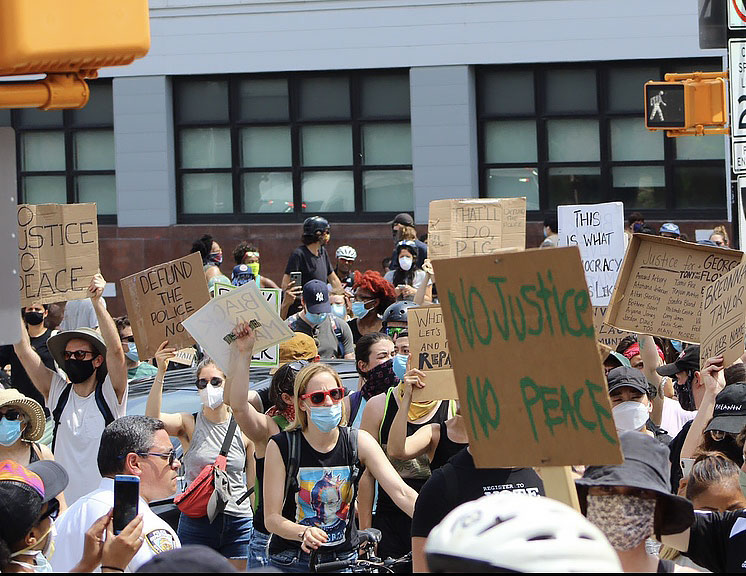Issue 5 2021 Short Essays
The Role of the Fanny Pack in 2020
Ivana Maldonado

Fig 1. A front line worker from VCMA Auxiliary wearing her green fanny pack donated by Baggallini. VCMC Auxiliary, Frontline Staff, April 27, 2020.
The fanny pack is a utilitarian object which has existed for approximately 5,000 years and slowly evolved into a fashion item of the twenty-first century.1 The earliest known fanny pack-style accessory dates to between 3400 and 3100 BCE. This prehistoric purse was discovered in September 1991 in the Ötztal Alps in Switzerland, alongside the 5300 year-old, naturally mummified remains of “Ötzi the Iceman.” The simple pouch, made from a thin calfskin strip, was attached to Ötzi by a leather belt, which was also created by another thin calfskin strip, 4 to 5 centimeters wide. Inside Ötzi’s fanny pack, scientists discovered various tools, including tinder fungus, a scraper, a boring tool, a bone awl, and a flint flake.2 Other cultures utilized a similar pouch and belt accoutrement; ancient Egyptians hooked linen sacks to their shendyt garments,3 Japanese men in the seventeenth century commonly used small, ornate, lacquered inro attached to their kimonos with a cord,4 and Victorian women often fastened lavish metal chatelaine bags to their dresses to carry keys and other valuables on their person.5 The modern fanny pack, as we would recognize it today, emerged in the twentieth century, gaining popularity in the United States during the 1980s.6 This version of the fanny pack consisted of a bulky pouch attached to a thick waist belt often made from nylon and available in a variety of colors. As nostalgia for 1970s and 1980s sportswear arose in the twenty-first century, the fanny pack, also referred to as bum bag, waist pack, hip pack, belt bag, utility pack, and crossbody bag, has made a comeback due in part to its functional purpose. Many luxury fashion brands such as Chanel, Louis Vuitton, Gucci, and Hermès have marketed their version of fashionable yet functional fanny packs. Most notably, Louis Vuitton launched their 2021 Bumbbag Dauphine BB, a multipurpose bag with adjustable straps allowing it to transform from a waist belt to a crossbody chain pouch or a square clutch bag.7
Despite the adoption of the fanny pack as an accessory within the realm of high-fashion, the object’s overall design remains rooted in the practical, with functionality as the core of its identity. It remains a pragmatic fashion choice, as exemplified during both the COVID-19 pandemic and nationwide racial justice demonstrations which took place this past year. In the wake of the pandemic, the use of fanny packs within the healthcare space increased exponentially with companies such as Baggallini donating fanny packs to frontline workers across the country.8 The medical utility belt for these fanny packs is made from antimicrobial nylon fabric, contains five slots to hold medical supplies, and has a locking zipper to comply with HIPAA regulations and is water resistant.9 This fanny pack is versatile, provides fast access to medical supplies when moving around, and accommodates to COVID-19 safety protocols.10 Healthcare workers, particularly those nurses working at Ventura County Medical Center, have expressed their enthusiasm for the gear, stating that the bag “is the perfect size for use around the hospital… I love the functionality of it for work and it provides a safe space to keep belongings.”11 Through their versatility and overall utility, the fanny packs clearly contribute to the overall well-being and workflow of front line workers (Fig 1).

Fig. 2 A racial justice demonstration that spans from Downtown Brooklyn to lower Manhattan in honor of Breonna Taylor and George Floyd. Leonardo Maldonado, Protestors in downtown Brooklyn, June 6, 2020.
Activists in 2020 also took advantage of the practical accessory. Protesters demanding racial justice took to the streets wearing two prominent accessories—face masks to protect themselves from the spread of COVID-19 and fanny packs to carry essentials such as keys, extra face masks, snacks, wallets, and hands sanitizer (Fig 2). The fanny pack allows for protesters to easily carry signs by freeing their hands and removing the added weight of large bags. Dr. Nathalie Duroseau of Mount Sinai attended a Black Lives Matter protest in New York City stating, “Before protesting pack light…I personally went with a fanny pack which held my hand sanitizer, snacks, water, phone, and keys.”12 The fanny pack’s versatility and modern design has enhanced protesters’ agility during the COVID-19 pandemic and offers convenience that’s lacking in handbags and other large bags. In a year devoid of fashion choices, the fanny pack underwent a fashionable incarnation, becoming the accessory of choice for activists and healthcare workers. However, the fanny pack is also ideal for non-pandemic activities, whether it’s hiking, running, cycling, riding the subway, attending concerts, or traveling, as society shifts back to normality.
is a graduate student in the History of Design and Curatorial Studies program at Parsons School of Design and is a fellow in contemporary design at Cooper Hewitt, Smithsonian Design Museum. She is on the Design Team for the fifth issue first online version of Objective.
Notes
- “Ötzi the Iceman: The Discovery,” South Tyrol Museum of Archeology, accessed March 25, 2021.
- “Ötzi the Iceman: Clothing,” South Tyrol Museum of Archeology, accessed March 25, 2021.
- Vanessa Davies, “Hatshepsut’s Use of Tuthmosis III in Her Program of Legitimation,” Journal of the American Research Center in Egypt 41, (2004): 55-66.
- “Articles: Netsuke & Inro,Victoria and Albert Museum, accessed December 1, 2020.
- Christopher Todd Matthews, “Form and Deformity: The Trouble with Victorian PocketsRachel Tashjian,” Victorian Studies 52, no. 4 (Summer 2010): 561-590.
- Kaiane Habeshian, M.D., Anna Yasmine Kirkorian, M.D.,Kalyani Marathe, M.D., M.P.H, “The Fanny Pack: No Ifs, Ands, or Buts,” Pediatric Dermatology 34, no.3 (2017): 377-379.
- “Handbags: Bumbag Dauphine BB,” Louis Vuitton, accessed March 25, 2021.
- “Data & Insights: Confronting Coronavirus: How Hospitals Are Transforming in Coronavirus Fight,”American Hospital Association, accessed December 21, 2020.
- “The Trustee-Anti-Microbial Medical Supply Organizer Belt Bag Utility Belt -Grey in 2 sizes,” New Gear Medical, accessed December 4, 2020.
- “Covid19 Response: Thank You Healthcare Heroes!,” Bagg, accessed December 21, 2020.
- Ibid.
- Nathalie Duroseau, DO, “How to Protest Safely During Covid-19: An Adolescent Medicine Specialist’s Perspective,” Mount Sinai Adolescent Health Center, June 19, 2020.
